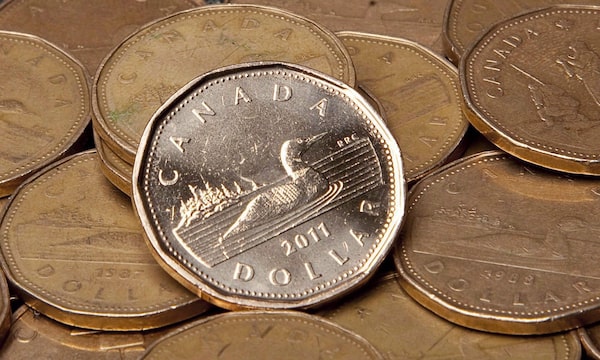
Canadian dollar is experiencing a bullish surge right now.JONATHAN HAYWARD/The Canadian Press
An optimistic tone struck by the Bank of Canada on Wednesday extended the Canadian dollar’s recent hot streak, which has seen the loonie rank among the best-performing major currencies this year.
The central bank laid out a vision for a faster economic recovery, shortened the timeline for expected rate hikes, and pared back its bond-buying program.
Taken together, these measures amount to a first step in withdrawing the extraordinary levels of intervention triggered by the pandemic. In response, the Canadian dollar gained about 1 per cent against the U.S. dollar to hit an intraday high of 80.28 U.S. cents – close to its highest level in more than three years.
The currency’s bullish run continues in spite of a virulent third wave of COVID-19 infections, and the resulting round of regional lockdowns meant to stifle the outbreak.
Meanwhile, the astronomical fiscal deficits and the billions in new spending laid out in the federal government’s budget this week also did little to dampen appetite for the country’s currency.
“For the Canadian dollar bears – and there’s still a large number of them out there – I think they’re still scratching their heads,” said Greg Anderson, Bank of Montreal’s global head of foreign exchange strategy.
To find out why the Canadian dollar has been so strong, look no further than commodity markets, Mr. Anderson said.
As the world economy emerges from the pandemic, burgeoning growth has reignited demand for commodities, while supply constraints have been slower to overcome. The net result is upward pressure on prices of everything from forest products to base metals to crude oil.
The Bank of Canada’s commodity price index is up by 138 per cent over the past year, and recently hit a six-year high. A barrel of Western Canadian Select (WCS) has been trading in the US$50-range since mid-February, after plunging to less than US$5 a barrel in the midst of Canada’s first wave of COVID-19 infections last year.
The revival in energy markets has helped maintain a surplus in Canada’s trade balance in recent months, and will likely produce a quarterly current account surplus, Mr. Anderson said – the country’s first in more than 10 years. Balance of international payments data for the first quarter should be available in late May.
Even with the gains in the Canadian dollar in recent weeks, the currency has yet to catch up to Alberta crude’s new-found bullishness, Mr. Anderson said. “Foreign-exchange markets are going to want to see that for another two or three months.” If, at that point, WCS is still trading around US$50 a barrel, expect the loonie to pick up another two or three US cents, he said. Not since May, 2015, has the currency breached the mark of 83 US cents.
It’s not a given, however, that energy markets will remain quite so buoyant. Earlier this month, the Organization of the Petroleum Exporting Countries and its allies announced it would start to roll back supply constraints put in place last year to stabilize the global energy market. “The enthusiasm around crude prices that drove [the loonie’s] gains has since been tempered,” CIBC economist Katherine Judge wrote in a recent report. “The Canadian dollar no longer looks set to appreciate, and will likely remain steady into mid-year.”
The boost to the loonie from the Bank of Canada’s growth upgrade could also be fleeting.
The magnitude of Wednesday’s move in the dollar suggests investors were surprised by the extent of the central bank’s hawkish shift in tone. The new guidance suggests rate hikes could begin as early as the second half of next year. “Doing so opens up a notable gap with a still-cautious Federal Reserve that is claiming that it can wait until 2024 for U.S. rate hikes,” Avery Shenfeld, chief economist at CIBC World Markets, wrote in a note.
But it is unlikely Canadian rates will be hiked before the U.S. Federal Reserve makes its first move. With the United States well ahead of Canada on administering COVID-19 vaccines, the U.S. economy is also tracking toward a full economic reopening sooner.
“The push to the loonie should at some point be reversed when the Fed also comes around to a more optimistic take,” Mr. Shenfeld said.
Be smart with your money. Get the latest investing insights delivered right to your inbox three times a week, with the Globe Investor newsletter. Sign up today.
 Tim Shufelt
Tim Shufelt